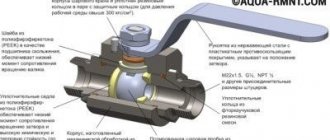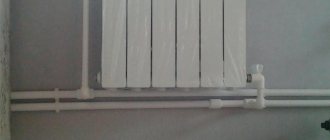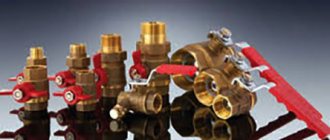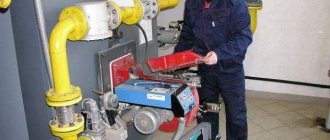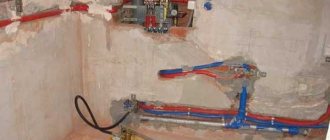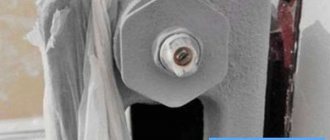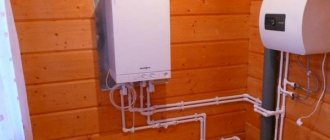Noise in heating pipes is a familiar problem not only for those who live in an apartment, but also for residents of private houses. The causes of extraneous sounds can be very different, but they must be diagnosed and eliminated. To avoid possible troubles, the appearance of any noise in the heating system should be treated very carefully. The Plumber Portal website will tell you how to identify the main reasons for the appearance of extraneous sounds in the heating system and how to eliminate the problem.
What types of noise can pipelines make?
The sounds emanating from heating system elements are legendary. Under certain circumstances, not only heating pipes make noise in the house, but also other pipelines. At the same time, the sound range of all sanitary systems is approximately the same. The most “musical” ones are metal pipes, but they also play unusual melodies. A water heating system can make a wide variety of sounds:
- murmur;
- gurgling;
- rattling;
- knock;
- crack;
- clicks;
- hum;
- whistling;
- howl.
Specific sounds signal the presence of problems in the heating system, so it is necessary to quickly identify and eliminate the source of the noise, since systematic exposure to it leads to disorders of the nervous system, interferes with sleep and reduces performance. Why is water noisy in heating pipes * Noise in heating pipes is caused by the following reasons:
- air jams;
- high speed of coolant movement due to incorrectly selected pipeline diameter or a decrease in the internal lumen of the pipe due to overgrowing of its walls;
- coolant leakage in emergency areas or through poorly closed valves;
- scale peeled off from the pipe walls or debris that got into the circuit during installation;
- faulty or incorrectly installed valves;
- excessive pump power or improper installation;
- wear of control valves or thermostatic heads;
- cavitation - the formation of steam bubbles in the coolant in the area of a sharp increase in the diameter of the pipeline (the appearance of an area of low pressure) with their subsequent collapse, destroying the equipment;
- violations of installation technology (use of polypropylene pipes with a diameter smaller than the calculated one, failure to observe the minimum distance between parallel sections of a metal pipeline during installation, installation of a filter or valve not in the flow direction indicated on it, etc.).
Important! The central heating always turns on noisily. When the system is filling, you can hear the murmur of the coolant, the heating of the circuit is accompanied by clicking sounds, and the air coming out of it is accompanied by a whistle. Maintenance of heating equipment before start-up can also be carried out using impact. Such noises usually disappear once the system is operational and are not a cause for concern.
*
If extraneous sounds appeared at the height of the heating season or did not disappear after the start-up took place, then this is a signal of the presence of malfunctions, and you should look for malfunctions not only in yourself or your neighbors in the riser, but also in the heating point or elevator unit - the source of the trouble may be far away outside the home, since sound waves travel well through pipes.
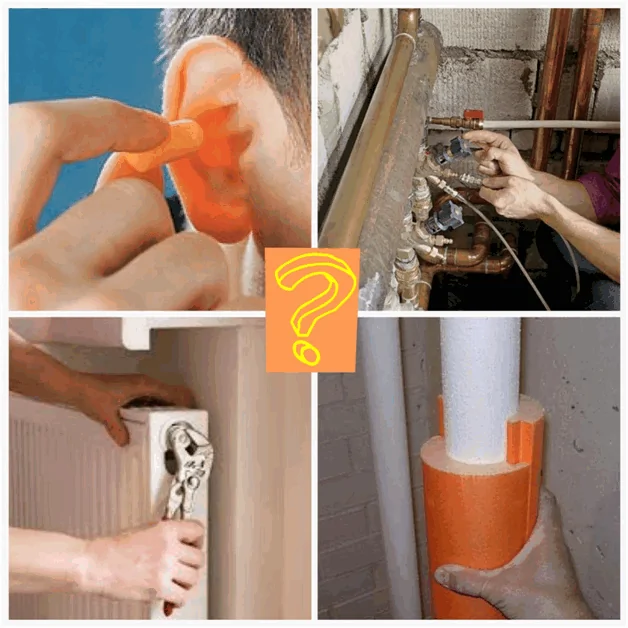
Methods for neutralizing noise
The source of noise often turns out to be in the locations of public utilities. The coolant pressure at the heating main entry point is the highest, so the slightest malfunction in it can immediately manifest itself in the form of strange sounds throughout the entire entrance. In a private house, the noisiest place is the furnace or heat generator room, where the boiler and its entire piping system are located.
Note: Aluminum and bimetallic radiators are especially sensitive to pressure changes. Thin metal transmits any vibrations through itself, like a megaphone. In such heating devices, the slightest technological noise acquires an amplified sound.
If the problem turns out to be a malfunction of collectively owned equipment, then you should not fix it yourself. Worn-out components can literally crumble at the slightest attempt to unwind them, and all the blame will be placed on the one who unauthorizedly interfered with the operation of the “perfectly debugged” system. It is better to send a complaint to the service organization and patiently wait for their representative to repair the faulty components.

A visual reminder with the coordinates of addressees if it is necessary to contact housing and communal services issues
*
If you were able to diagnose problems within your own or a neighbor’s home, then you should begin to eliminate them as quickly as possible. In this case, any delay is fraught with aggravation of the situation and complication of repair work.
Shooting and knocking of radiators
Metal radiators sometimes produce sharp sounds that resemble gunshots. These sounds are a consequence of the expansion of the metal: structural elements made of this material increase when heated and decrease when they cool. To prevent this factor, experts recommend using special insulation for pipes that are located close to the walls.
In addition, these sounds may be the result of improper installation of the structure or violation of the rules for attaching heating batteries. To prevent this problem, you must strictly follow the installation instructions and the recommendations of specialists:
- the distance between the floor and the radiator should be 14 centimeters;
- the battery should be located at least 10 centimeters from the windowsill;
- there should be a distance of 5 centimeters between the wall and the battery (you can place a layer of insulation in it);
- pipes must be installed on a flat vertical surface;
- It is recommended to raise the end with the air outlet by a centimeter.
In addition, periodic knocking noises may be heard in the heating system. Usually their occurrence occurs due to the difference in the diameters of the pipes used in the manufacture of the structure.
To prevent this malfunction, it is recommended to use elements with the same dimensions when installing the system. Instead of a diaphragm, it is better to install a regulator that monitors the pressure drop of the water supply to the heating battery.
The occurrence of extraneous sounds may also indicate that the service life of some structures has expired. You should diagnose the condition of the heating system and, if necessary, replace the radiator yourself or ask for help from specialists.
Humming, howling
The loudest and most unpleasant type of noise. Pipes can start buzzing out of the blue and give rise to poltergeist stories. However, mysticism has nothing to do with it, and communication with spirits will not save you from noise in the pipes.
When a hum occurs, you need to look for a coolant leak. First of all, a thorough inspection of your home is carried out, then all neighboring apartments. If everything is dry, then the search continues in the basement. A cloud of steam, a puddle or a whistle will help you easily determine the place where the water is leaking. In apartment buildings, repairs will be carried out by the management company, in private houses - by the owner of the property. After inspecting the problem area, a decision is made on how to eliminate the malfunction - by repairing or replacing the unit; sometimes it is enough to simply tighten a poorly closed valve.
Another reason for the hum may be the use of pipes in the heating system with a diameter smaller than the calculated one. In this case, the problem area is determined by ear, and the required section of the pipeline is replaced with material with greater permeability. With the correct selection of pipes and high-quality performance, you will no longer have to listen to the pipes hum.
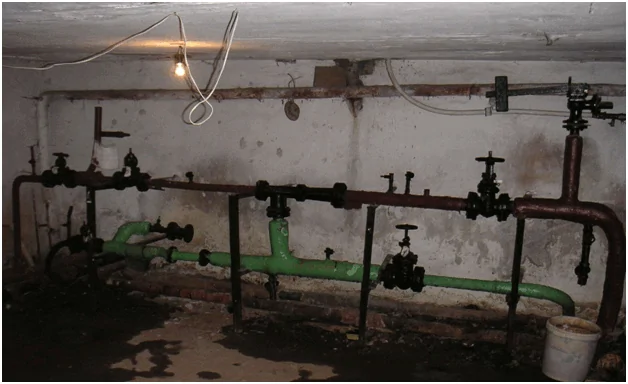
Distribution unit of a central heating system in the basement of an old apartment building
Why are extraneous sounds in pipes dangerous?
Silencing noisy pipes or radiators is not a solution to the problem. The occurrence of extraneous noise in the pipeline is a sign of a problem. A sewer or heating system assembled without any defects does not emit any extraneous noise. The roar and clanging that disturbs the sleep of the inhabitants of the home at night is a signal that it is time to contact a repairman.
Residents can put up with barely audible noises for years. But owners who don’t give a damn about a slight hum and believe that this problem does not deserve attention and that no measures should be taken to eliminate it are acting extremely recklessly.
Mechanical noises are a sign that a breakout is likely, but a slight hum is also a serious danger. Not all sound vibrations can be distinguished by human hearing. Ultrasound, for example, can only be heard by animals.
Vibrations of pipes and subtle whistles are practically not disturbing, but these factors can affect the occurrence of migraines, deterioration of general health, poor sleep and fatigue. City noise interrupts this problem during the daytime, but nevertheless does not eliminate it completely; even soundproofing materials cannot get rid of it. As soon as the “singing” of trumpets was heard, you need to immediately take care of diagnostics and repairs.
Bubbling, crackling and clicking
Particles of debris, sludge or exfoliated scale, when moving through the pipes, hit the walls and rub against them, creating noise in the form of crackling or seething. A characteristic sound when clogged is also a clicking sound. To eliminate this type of noise, it is necessary to flush the system.
Foreign objects in the pipes will click until they come out. Therefore, all liquid is drained from the system through the drain valve. Using a hose, the old coolant with debris is directed into the sewer, the system is additionally washed with water (steel pipes are tapped on the outside with a wooden mallet to remove scale from the inside from the walls), after which the heating circuit is refilled.
Important! Before draining dirty water, it is better to dismantle the drain valve to allow large pieces of debris to come out and not clog the shut-off device.
*
Quite often, pipes crack and click due to a malfunction of the valve or its installation in the wrong direction of flow. The curved passage hole easily becomes clogged, and over time a plug may form in it, completely blocking the movement of the coolant. Partial blocking of the pipe lumen with debris creates noise when water passes through. If the valve is positioned the other way around, then liquid enters it not from the bottom side of the locking disc, but from above, which leads to destruction of the stem and separation of the valve. In this case, the movement of the coolant will also be accompanied by noise.
The most rational way out of the situation is to replace the valve, since it is already partially worn out in the wrong position and is therefore unpredictable after reinstallation. In the absence of a new unit, you can temporarily install the old one by replacing the sealing material of the threaded connections.
Advice: When choosing new shut-off and control valves, you need to keep in mind that ball (plug) valves are much more practical to use, can be installed in any direction and are not as sensitive to blockages as screw valves.
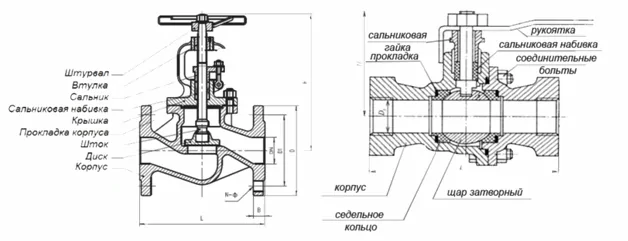
If you close the ball valve tightly, it can also become a source of noise. This is not a malfunction and can be corrected by opening it slightly or closing it completely. Valves with thermostatic heads can also make noise if the temperature set on them is close to the actual temperature in the room. In this case, the entrance to the radiator is not completely blocked, and the coolant passes through a small hole with a characteristic sound. To get rid of the noise, simply turn the head towards the sprocket.
Which elements are more likely to go into heat than others?
First of all, fistulas appear along the welded seams of electric welded pipes. To fix this problem, it is best to contact a specialist, but some leaks can be fixed yourself. Tightening or filling the seal on a plug tap or valve yourself is not difficult.
Threads leak very often. For example, at the connection of the locknut with the coupling on the downstream. All you need to do is lightly tighten the lock nut, or by blocking the risers (yours and the other one), slightly unwind the lock nut along the thread, then re-wind the plumbing flax and tighten the lock nut securely.
Murmuring, whistling
When air accumulates, you can hear the water bubbling in the heating pipes - a very common phenomenon. Air can enter the system during repair work, or be sucked in through loose connections - an air lock, regardless of its origin, prevents the normal circulation of the coolant. Not only does the water gurgle annoyingly, but the heating devices do not heat up properly. If an air lock forms that completely blocks the lumen of the pipe, the radiators after the problem section of the pipeline will remain cold.
Air always accumulates at the highest points of the system, since it is lighter than water. This is where special valves or automatic air collectors are usually installed. Radiators located at the end of a horizontal branch must be equipped with a Mayevsky tap. In some types of systems, each heating device has a so-called “air vent”. The units of modern designs can be easily turned by hand; older ones will have to be controlled using an adjustable wrench or a screwdriver.
First of all, you need to try to bleed the air from the radiators of your apartment. The operation begins with the coldest device, if available. Often it is local air pockets that interfere with heating. If this does not give results, then you need to ask your neighbors on the top floor to find the appropriate tap and open it. In difficult situations, it is better to call a qualified plumber. An indicator of success - the release of air - is a characteristic whistle.
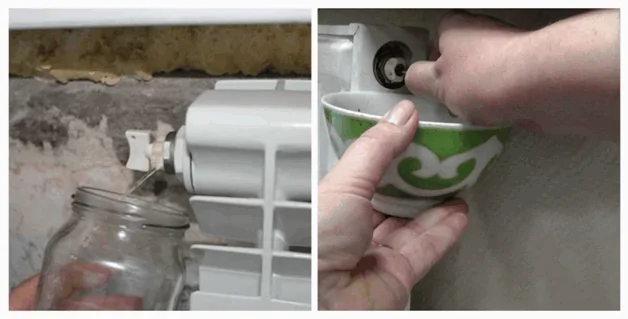
Tip: To avoid getting burned, you need to open the Mayevsky tap smoothly, being careful - the hot water in the system is under pressure. In addition, to collect water that will flow from the radiator, it is necessary to first prepare a container of sufficient volume with a wide neck.
*
Murmuring and gurgling in pipes
Quite often gurgling and babbling can be heard in pipes. As a rule, these sounds are typical at the beginning of the heating season when the system is filled with water.
If these sounds are not a consequence of starting hot water, then they may indicate the following problem: an obstacle has arisen inside the radiator and the coolant has to flow around it, which is why these sounds are heard.
In order to determine the cause, it is necessary to verify the position of the valve and its functionality, and also try to determine the presence of a blockage. For prevention, it is recommended to clean the system; this can be done using the following methods:
- Using powerful water pressure.
- Using special chemical reagents with further flushing of the system with a jet of water under pressure.
If these measures are ineffective, you should seek help from a specialist, since in case of serious blockage you will need to seek help from a welder.
Knocking, rattling
The cause of the knocking noise is usually a poorly secured pipe or radiator bracket. The slightest vibration when the coolant passes through such a unit causes rattling, and if the supports are very loose, the radiator hits the fasteners. The system will stop making noise if the brackets are firmly fixed. To dampen vibration, you can install a heat-resistant rubber gasket between the device and the support.
Sometimes knocking noises can be caused by parallel or intersecting pipes being too close together. During temperature deformations, one pipeline begins to touch another, beats against it and becomes a source of noise. Sound insulation can save the situation if the available gap is enough to accommodate it. Otherwise, to eliminate the knocking, you will have to shift the problem area.
In some cases, knocking on heating pipes in apartment buildings is caused by dissatisfaction with neighbors. This type of noise is usually characterized by a lack of periodicity and occurs in the form of a reaction to certain provoking actions. It’s just that all residents have to “enjoy” the specific sounds. Technical measures will not help here; sound insulation can only partially save. Conflicts with neighbors can only be resolved through dialogue and diplomacy.
Elevator noise
If you live on the ground floor, the source of uniform noise may well be the elevator unit - the thermal heart of the house.
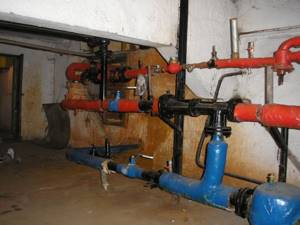
Elevator unit
Symptoms
A quiet low-frequency hum comes from heating and hot water risers.
Cause
Regular operation of the water jet elevator. In its mixing chamber, water from the supply line of the heating main is injected into the coolant from the return line - colder and with a lower pressure.
Thus, circulation of a large volume of water is achieved and, accordingly, uniform heating of heating radiators throughout the house with minimal water consumption from the supply pipeline.

The principle of operation of the elevator
Hint: minimal supply water flow means reduced pressure drop over long sections of heating mains.
Solution
There is no reasonable solution to the problem, precisely because we are talking about the normal operation of the heating system.
However, there are two good news:
- It's easy to get used to the uniform, quiet noise. Usually, a few days after starting the heating, it ceases to be perceived by the ear and turns into a familiar sound background;
- The elevator is noisy only during the heating season. In the summer, when the heating is turned off, the difference between the supply and return lines is reduced to a minimum, and hydraulic noise disappears.
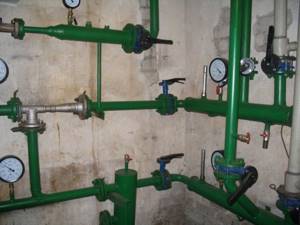
In summer, the pressure difference between the supply and return lines is minimal or absent
Expert advice on preventing unwanted sounds from appearing in the heating circuit
The likelihood of noise in heating pipes can be reduced by adhering to the following professional recommendations:
- when welding polypropylene pipes, strictly observe the heating time of the parts being joined, since overheating leads to a decrease in the working clearance, and underheating leads to low reliability of the connection and a high probability of leakage;
- bend metal-plastic pipes using a pipe bender to avoid reducing the diameter of the pipeline in the bending section;
- heating circuit pipes must be equipped with heat and sound insulation;
- when welding metal electrically, you need to use only high-quality electrodes of the appropriate brand;
- at the highest points of the heating system and at the last devices of each branch, it is necessary to have Mayevsky valves for air release;
- valves and filters must be installed only in accordance with the specified flow direction;
- the pump power must correspond to that required for a particular system;
- To avoid airing, radiators should be installed strictly horizontally - using a bubble or laser level;
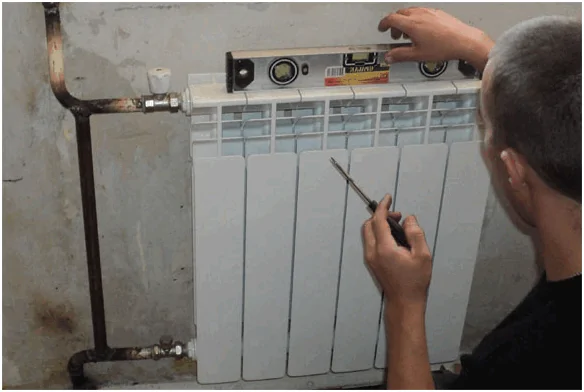
Checking the installation of a bimetallic radiator using a bubble level - debris, welding drops, etc. entering the heating system pipeline. not acceptable;
- In order for the switched-on pump to make less noise during operation, it must be installed on vibration inserts and equipped with a sound-insulating casing;
- in autonomous heating systems, it is important to monitor the condition of the pumps, since the slightest malfunctions significantly increase the level of noise emanating from them; Changing the operating mode of the pump sometimes allows you to get rid of shocks and clicks;
- using only high-quality plumbing fixtures, fittings and auxiliary materials significantly reduces the risk of extraneous noise;
- It is necessary to periodically flush the system, preventing a decrease in the working clearance of the pipes due to various types of deposits and the associated appearance of unpleasant sounds.
Important! In searching for the source of noise, a dry stick (the handle of a shovel) can help, one end of which is pressed tightly to the ear, and the other - alternately to the elements of the heating system. In the problem area, the noise will manifest itself louder and clearer.
Noise in radiators
To correctly diagnose the causes of noise in the battery, you should make sure that it is in normal technical condition. Often, when inspecting the radiator, damage is discovered. In this case, it should be repaired or replaced with a new device. If there is no obvious damage, it is necessary to determine the type of noise. Most often you can hear a hum and/or clicking noise in the radiator.
Their causes include the following common problems:
- Incorrectly installed battery.
- When moving, the water flow transmits vibration to the radiator, which in turn transmits vibration to the mounting units located in the wall.
- There is a foreign object inside the device. Often, once it gets into the system, it settles in the battery. Either this item was there initially and was not removed during installation.
- Air has entered the radiator. This causes the noise of flowing coolant or hum to appear in it.
- Incorrect functioning of the thermostat. The reason for this is the displacement of the shut-off rod.

You need to start fixing problems only after correctly diagnosing them. If the cause of extraneous noise is in the central heating main, you must contact the management company. When extraneous sounds are heard for a long time, you should call specialists to carry out diagnostics.
Noise you need to pay attention to
To find out why the heating battery is cracking, you first need to check its technical condition. If damage is detected during inspection, the battery is repaired or replaced. If there is no damage, determine the type of noise. The reason why radiators click may be the following:
- improper pipe laying;
- connection of various additional devices (Maevsky tap, shut-off valve, bypass, meter, etc.);
- movement of scale or foreign body trapped in the coolant;
- vibration of the rod and its knocking on the body of the thermal valve as a result of the wrong direction of water flow;
- moving radiators to another location;
- increasing battery power and operating pressure.
Sounds caused by cavitation at high flow rates are not a sign of danger. It’s another matter if they are associated with an increase in internal tension in the system, which can cause a breakthrough.
Reasons for increased internal tension:
- general wear and tear of systems, including valves and taps;
- The upper battery nipples are tighter than the lower ones.
Sounds can be caused by the characteristics of heating boilers. When the draft of solid fuel boilers decreases, crackling and clicking sounds appear, and if a large amount of soot has formed in the diesel fuel boiler, this may be the reason why the heating radiator hums.
Causes of battery noise and how to eliminate them
As already mentioned, the main cause of noise is rust. But pipes, a radiator or a riser can make noise. We will consider the noise in the pipes last, since the tenant is not able to fix this problem on his own. It will be a matter of communications located on the technical floors. You will have to check the pump, vibration inserts, etc. The easiest option to fix is a radiator malfunction.
Metallic knocking, scraping, and slight squeaking can occur in only two cases. The first and most unlikely: poor radiator mounting. If you have recently moved into an apartment or have recently repaired your heating system, then it may well be that the installer did not secure the radiator to the brackets properly. Or, as a result of hydraulic disturbances, pressure surges or expansion of devices, the brackets themselves became loose. In this case, you just need to check the fastenings and put gaskets in place where the mechanical parts come into contact.
The second option is much more complicated. The fact is that in open heating systems, suspended particles from heating plants, despite the filters, often end up in the radiator. To these are added loose rust particles. This mixture travels through pipes, often remaining in radiators. With large accumulations of particles and high pressures, these particles begin to hit the inner walls of the radiator. To solve the problem, you will have to disconnect and clean the radiator.
There are two ways to clean the radiator:
- Chemical. Fill the radiator with a compound that corrodes and dissolves contaminants. After the procedure, the liquid is drained, and the radiator is again ready for use.
- Mechanical. The radiator is flushed with a powerful stream of water, which washes away all contaminants.
A hum or whistle clearly indicates a violation of the hydraulics of the heating systems. There may be several reasons for this:
- Improper balancing of whole house hydraulics. The fact is that all houses powered by the central heating main and connected according to a dependent connection scheme are interconnected. This is achieved by selecting a certain diameter of the balancing valve or installing a throttling nut on the thermal input of the building. If the nut was selected incorrectly or the valve was incorrectly adjusted, the coolant may not reach the upper floors or circulate through the pipelines too quickly. As a result of “too fast” circulation, sounds resembling a hum arise. To solve the problem, you will have to call a plumber to rebalance the system.
- Another option is possible as a result of repairing the main heating communications in the technical floor. If pipes of a smaller diameter were used or the number of pipe transitions was increased without recalculating the hydraulics, then the hydraulic connection of consumers already inside the building is disrupted. The solution is still the same: call a plumber to solve this issue. The simplest solution seems to be installing a balancing valve in front of the heating risers on the technical floor. But the most rational solution depends on each specific case.
- The last option is the fault of the tenant himself, that is, a violation of the apartment’s hydraulics. The situation may arise as a result of improper repairs or an attempt to independently regulate the heat supply to the apartment using a balancing valve. The heat supply to the apartment must be regulated by a professional. To correct the consequences of improper repairs, you will have to install a balancing valve at the entrance to the apartment. In the second case, it will be enough to return everything to its original position or call a plumber.
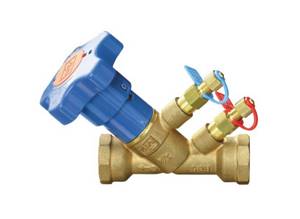
Balancing valve
Murmuring
In the case of gurgling, gurgling and other sounds of flowing water, the answer is clear: air locks are to blame. Air appears in heating systems for a variety of reasons. The most common:
- Pipe leakage
- Incorrect filling of the system with water
- Use of untreated water in heating.
In any case, there will be one solution: you need to bleed the air. Scientifically speaking, “de-air” the system. To do this you need to use the Mayevsky crane. Counterclockwise, the tap is opened half a turn using a screwdriver or a triangular wrench, the air comes out. After water starts flowing from the tap, the device also closes. If air locks occur on a regular basis, then you should contact a plumber to check the condition of the pipes in the house for leaks. Air can appear in heating systems as a result of leaks.
Where can I complain?
Normally, pipes and batteries should not make noise. If the sounds are disturbing, you must first contact the house management company with a written complaint. If measures are not taken, you can complain sequentially to the following organizations:
- local body of the State Housing Inspectorate;
- local branch of Rospotrebnadzor;
- local authorities;
- prosecutor's office
If the owner of the living space entrusted the installation of the radiator not to the management company, but to other organizations, he must contact them. Problems may arise if there is no legal act of acceptance of work. In this case, the service of a heating engineer will be paid. In some cases, it is necessary to reconfigure the entire heating system.
If a defect is discovered in the radiator, and the certificate of acceptance of the radiator into operation issued by the organization that installed or replaced it has been preserved, and the warranty period has not yet expired, you can request that this organization carry out diagnostics and free repairs.
